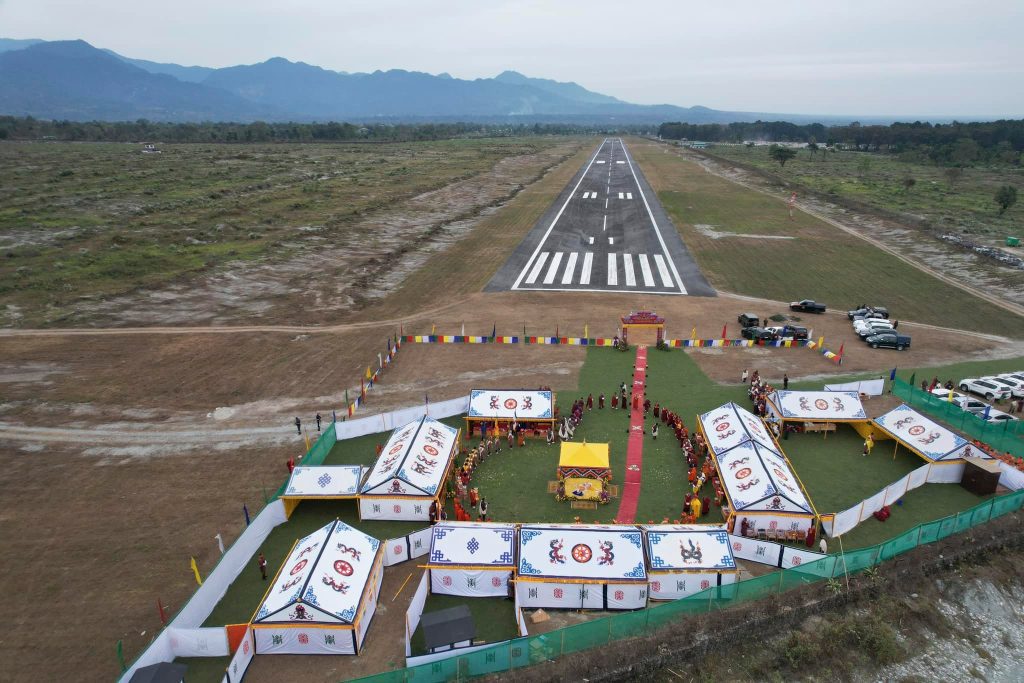Gelephu International Airport, situated in the picturesque Samtenling Gewog of Sarpang District, Bhutan, represents a significant milestone in the country’s aviation history and economic development. This ambitious project, part of Gelephu Mindfulness City, began back in the day as a domestic airport and is now being made as an international gateway, embodying Bhutan’s vision for sustainable growth, enhanced connectivity, and balanced regional development. As we study this transformative project, we’ll explore its historical development, current status, and the far-reaching implications it holds for Bhutan’s future.

Historical Development and Early Challenges
Gelephu Airport began with great aspirations but faced several challenges along the way. Initially inaugurated in October 2012, the facility experienced a five-year delay in regular scheduled operations due to certification requirements and funding constraints. This period of development was crucial, as it included significant upgrades such as the construction of a new terminal building and control tower.The airport, spanning over 500 acres (200 ha), is strategically located about three kilometers (1.9 mi) from Gelephu town. Its positioning at coordinates 26°53’04.46 N, 90°27’50.98 E and an elevation of 300.9 meters (987.204 feet) above mean sea level places it advantageously at the foothills of Bhutan’s terrain, offering excellent connectivity potential.
During its early years, the airport faced several operational challenges. The lack of certification from the Department of Civil Aviation of Bhutan and funding issues delayed regular scheduled operations. Initially planned as an international airport, this ambitious vision was temporarily shelved in 2008. In January 2015, the Department of Civil Aviation announced the closure of the airport to scheduled flights due to the need for constructing a new terminal building and control tower. Despite hopes for a quick reopening, it was reported that Drukair, Bhutan’s national airline, was unaware of the airport’s reopening plans and stated that it would not launch commercial flights until market conditions ensured viable scheduled operations. After a brief period of flights in 2015, which were found to be uneconomic, flights were eventually re-commenced in November 2017 with financial support from the Royal Bhutanese Government. This marked a turning point in the airport’s history, as it finally began to fulfill its role in enhancing domestic connectivity within Bhutan.
Infrastructure and Technical Specifications

Gelephu Airport’s technical specifications make it uniquely suited for both domestic and international operations. The airport currently features a 1500-meter runway oriented at 29/11, capable of accommodating ATR aircraft for domestic flights. This runway, while modest in size, has been crucial in establishing initial air connectivity for the region. The airport’s infrastructure includes essential facilities such as a terminal building, control tower, and basic navigation aids. These facilities, while initially designed for domestic operations, have laid the groundwork for the airport’s ambitious expansion plans. One of the key features of Gelephu Airport is its strategic location near the Indian border. This positioning not only enhances its potential as an international gateway but also opens up possibilities for cross-border connectivity and trade. The proximity to the Royal Manas National Park also positions the airport as a potential hub for eco-tourism, aligning with Bhutan’s commitment to sustainable development and environmental conservation.
Current Operations and Regional Connectivity
As of late 2024, Gelephu Airport maintains domestic operations with Drukair providing bi-weekly flights on Thursdays and Sundays. These flights have been crucial in connecting Gelephu with other parts of Bhutan, particularly the capital city of Thimphu and other domestic airports like Paro and Yonphula. The existing facility continues to serve domestic routes while preparing for expansion to accommodate regional international flights. Plans are underway to introduce flights to nearby Indian cities such as Kolkata, Guwahati, and Bagdogra. This regional connectivity is expected to boost trade, tourism, and cultural exchanges between Bhutan and its neighboring regions in India. Currently, the airport handles an average of 20 passengers on every flight, with the plane capacity being 30. This indicates a growing demand for air travel in the region, albeit with room for further growth. The introduction of international flights is expected to significantly increase passenger traffic and utilization of the airport’s facilities.
Transformation into a World-Class International Hub
The most ambitious chapter in Gelephu Airport’s history is currently unfolding with the announcement of its transformation into a landmark international airport by 2029. This transformation is part of the broader Gelephu Mindfulness City (GMC) initiative, with the airport economy serving as one of its core industries.The expansion project includes several key components that will elevate Gelephu Airport to international standards:
- A new 3,000-meter runway running parallel to the existing one, with the potential for future extension to 3,500 meters to accommodate larger aircraft like the Airbus A380.
- Capability to accommodate Airbus A320 family and A350 aircraft, significantly expanding the range of destinations that can be served directly from Gelephu.
- A state-of-the-art terminal building designed to handle increased passenger traffic and provide modern amenities.
- Advanced air traffic control systems and navigation aids to ensure safe and efficient operations.
- Enhanced cargo and logistics facilities to support international trade and commerce.
The estimated investment for this ambitious project is around USD 500 million for the first phase, highlighting the scale and significance of this development for Bhutan’s aviation sector and overall economy.
Economic Impact and Future Prospects
The development of Gelephu International Airport represents more than just infrastructure enhancement; it’s positioned as a crucial component of Bhutan’s economic future. The project has already attracted significant international investment, with Bhutanese living abroad pledging nearly 140 million US dollars through the Gelephu Investment Development Corporation. The airport’s initial phase targets 400,000 passenger movements, establishing itself as an aviation and logistics hub for the South Asian region. This increased connectivity is expected to have far-reaching economic benefits:
- Boost to Tourism: The international airport will make it easier for tourists to access Bhutan, potentially increasing international tourist arrivals. This is expected to contribute significantly to the country’s tourism industry, a key sector of Bhutan’s economy.
- Trade and Commerce: Enhanced air connectivity will facilitate easier movement of goods and services, potentially boosting Bhutan’s export capabilities and attracting foreign investment.
- Employment Generation: The airport project and associated developments are expected to create numerous job opportunities, both directly in aviation-related fields and indirectly in supporting industries like hospitality and logistics.
- Regional Development: The airport is expected to act as a catalyst for the development of the Gelephu region, potentially transforming it into a major economic center within Bhutan.
- Cross-border Connectivity: Given its proximity to the Indian border, the airport has the potential to serve over 5 million residents across the border, further enhancing its economic viability and regional importance.
Environmental and Social Considerations

In line with Bhutan’s commitment to environmental conservation and sustainable development, the Gelephu International Airport project carefully considers environmental impact and social responsibility. The expansion project integrates with 35 rivers and streams in the area, necessitating innovative engineering solutions to minimize ecological disruption.The development includes the construction of inhabitable bridges connecting various facilities, a concept that aims to reduce the project’s footprint while creating unique architectural features. These bridges are designed to house various facilities including a university campus, healthcare centers, and cultural attractions, embodying the project’s commitment to creating a holistic and sustainable urban environment.The project also includes comprehensive land acquisition and compensation programs for affected residents. Reports indicate that landowners whose properties fall within the airport expansion area have been provided with replacement land or compensation. This approach aims to ensure that local communities benefit from the development rather than being displaced by it. Furthermore, the airport’s design incorporates sustainable features such as the use of local materials like wood, stone, and bamboo, reflecting traditional Bhutanese architecture while adhering to modern sustainability standards. The plan also includes maintaining 70% of the land as forested green space, demonstrating a commitment to preserving Bhutan’s natural beauty even as it develops its infrastructure.
Technical Innovations and Infrastructure Development
The Gelephu International Airport project incorporates several technical innovations to ensure its success and sustainability:
- Advanced Geotechnical Surveys: Given the airport’s location in a seismically active region, extensive geotechnical surveys have been conducted to ensure structural stability and safety.
- Innovative Runway Design: The new runway, which will cross over several rivers, requires innovative engineering solutions to manage hydrological impacts while ensuring aviation safety.
- Smart Airport Technologies: The airport is expected to incorporate cutting-edge technologies in areas such as passenger processing, baggage handling, and security, aiming to provide a seamless travel experience.
- Sustainable Energy Solutions: In line with Bhutan’s commitment to carbon neutrality, the airport is likely to incorporate renewable energy sources and energy-efficient systems in its operations.
- Integrated Transportation Hub: Plans are underway to develop the airport as part of an integrated transportation network, including potential railway connectivity to enhance ground transportation options.
Challenges and Opportunities
While the Gelephu International Airport project presents immense opportunities, it also faces several challenges:
- Environmental Concerns: The project’s scale and its impact on local rivers and ecosystems have raised environmental concerns. Balancing development with conservation will be crucial.
- Financial Viability: The significant investment required for the project necessitates careful financial planning and management to ensure long-term sustainability.
- Operational Challenges: Expanding from a domestic to an international airport requires significant upgrades in terms of security, air traffic management, and regulatory compliance.
- Market Development: Attracting airlines and developing new routes will be crucial for the airport’s success, requiring strategic marketing and potentially government incentives.
- Skill Development: Training local workforce to meet the demands of an international airport operation will be a key challenge and opportunity.
Despite these challenges, the project offers unique opportunities:
- Economic Diversification: The airport can serve as a catalyst for diversifying Bhutan’s economy beyond traditional sectors.
- Technology Transfer: The project brings opportunities for technology transfer and skill development in aviation and related sectors.
- Cultural Exchange: Increased international connectivity can foster greater cultural exchange and understanding, aligning with Bhutan’s philosophy of Gross National Happiness.
- Regional Leadership: Successfully implementing this project could position Bhutan as a leader in sustainable aviation development in the region.
Conclusion
The transformation of Gelephu Airport into an international hub represents a pivotal moment in Bhutan’s development journey. It embodies the country’s aspirations for enhanced global connectivity while staying true to its principles of sustainable development and cultural preservation.As construction begins in the coming years, Gelephu International Airport stands poised to become not just an infrastructure project, but a symbol of Bhutan’s progress and its connection to the global community. The project’s success will depend on careful planning, sustainable execution, and the ability to balance economic development with environmental and cultural preservation.Looking ahead, the Gelephu International Airport project has the potential to redefine not only Bhutan’s aviation sector but also its position in the global economic landscape. It offers a unique opportunity for investors, policymakers, and the local community to participate in a development that could serve as a model for sustainable, mindful growth in the 21st century.As Bhutan embarks on this ambitious journey, the world watches with interest to see how this small Himalayan kingdom will navigate the challenges and opportunities presented by this landmark project. The success of Gelephu International Airport could well set a new standard for how developing nations can approach infrastructure development in harmony with their cultural values and environmental commitments.


